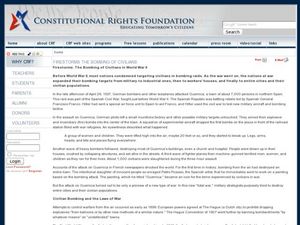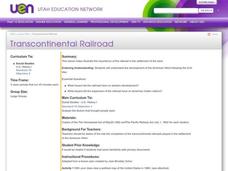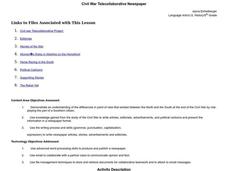Curated OER
Was There an Industrial Revolution? Americans at Work Before the Civil War
High schoolers investigate the First U.S. Industrial Revolution. They identify positive and negative effects of early industrialization, read first-hand accounts, role-play and interview individuals, and participate in a debate.
Curated OER
A State of Turmoil
Fourth graders complete a unit about the differences between the northern and southern states after the Revolutionary War. They view various online videos, conduct a debate about the issues that divided the nation, complete a Venn...
American Battlefield Trust
The Home Front
Women and children played key roles during the Civil War, even if their voices are often lost in history. By studying letters and personal testimony from them, budding historians get a glimpse into the day-to-day life of civilians during...
PBS
An Attack on Syria- What Would You Do?
Has United States military intervention in the conflicts of other countries always been warranted? After reviewing a brief background on contemporary US conflicts and reading articles describing the civil war in Syria, your learners...
NET Foundation for Television
1850-1874 The Kansas-Nebraska Act
How the Kansas-Nebraska Act created Bleeding Kansas is complicated—until scholars research and examine documents from the time. After completing activities that include mapping, photo, document analysis, and discussion, learners...
American Battlefield Trust
Pre-1861: Disunion
Nat Turner, John Brown, and Abraham Lincoln all played a key role in the run-up to the bloody American Civil War. Using a PowerPoint, timeline activity, and essay prompt, young historians consider the roles of these men and more to...
Curated OER
Firestorms: The Bombing of Civilians in World War II
Students examine the implication of civilian targets in war. In this World War II lesson, students investigate the history of bombing practices in war. Students zero in on World War II bombing practices as they discuss precision and area...
Curated OER
United States Colored Troops
Students explore the role that African American soldiers had in the Civil War and the impact they had on the US Civil Rights movement after the war. They complete a timeline, read an excerpt and analyze a primary image.
Curated OER
The Massachusetts 54th Regiment: Honoring the Heroes
Students use art and images analyze the Civil War. In this lesson on the Shaw Memorial, students engage in 3 activities, discussion, and art analysis to better comprehend the events of the Civil War. This lesson includes web resources,...
Curated OER
Sectionalism, Popular Sovereignty and Secession
Students read and discuss background material on several key decisions that played a role in the Civil War including the Missouri Compromise, the Kansas-Nebraska Act and the Dredd Scott Decision. They create a timeline and write an essay.
Curated OER
West Virginia State Museum Lesson Plan
Students explore historic West Virginia. In this US history lesson plan, students examine primary sources and political cartoons that depict the issues of statehood for West Virginia and the role that those played in the Civil War. This...
Curated OER
Brutal British
Young scholars read and predict the outcome of a story set during the Civil War, then map the story. To prepare for the activity, students determine why it is important to look at historical events from all angles by using primary and...
Curated OER
Reconstruction: A Time of Turbulence
Students utilize knowledge and understandings of the Civil War to look at the reconstructive era that followed. In this reconstructive era lesson, Students gain understanding of the definition of reconstruction by building, taking apart...
Curated OER
Transcontinental Railroad
Eleventh graders explain the development of the American West following the Civil War. They also explore the Homestead Act of 1862 and the Pacific Railway Act of 1862. They also participate in a simulation about the American West.
Curated OER
Underground Railroad
Learners navigate the Scholastic Underground Railroad site and listen to journey of the Underground railroad. In this Underground Railroad lesson, students use maps and compare and contrast the differences between the North and South...
Curated OER
Sectionalism
Students examine sectionalism. In this sectionalism lesson, students explore reasons sectionalism developed. Students realize the conflicts that led to the Civil War and how sectionalism affected citizens on the border of Kansas and...
Curated OER
What price Freedom! Civil War and Reconstruction
Fifth graders become familiar with the events of Reconstruction and the 13th, 14th, and 15th amendments. In this reconstruction lesson, 5th graders work in pairs where each student creates a building with blocks and draws it. Their...
Curated OER
American Women Who Shaped the Civil Rights Movement Explored Through the Literature of Eloise Greenfield
Examine the women who contributed to the Civil Rights movement. In groups, children read excerpts of writings from Eloise Greenfield and research the women she mentions using the internet. To end the lesson, they create a timeline of...
Curated OER
Women and the Civil War Era
Students explore feminism and explore the different roles of women and how they have changed over time. They read books about women in this period and evaluate the past, observe the present, and make assumptions about the future.
Crafting Freedom
Thomas Day's Letter to His Daughter, Mary Ann
Why is a letter a better way to learn about a person than a different primary source? Explore Thomas Day's ideas and advice to his daughter in a letter from 1851, which details the struggles of the American South before the Civil War....
Curated OER
Living History - Civil War
Eighth graders, after researching antebellum North Carolina and the role of North Carolina in the Civil War, write, edit, publish, and produce their own plays.
Curated OER
Civil War Telecollaborative Newspaper
Fifth graders analyze the different points of view in the Civil War. They role-play a Southern citizen, write and publish a newspaper article, e-mail a partner, and create a class newspaper with articles, editorials, ads, and political...
Curated OER
The Civil War Homefront
Students examine the human cost of war on both sides of the Civil War. Using the internet, they research the role of women on the homefront and the impact the war had on families. They also read the novel "Across Five Aprils" and discuss...
Curated OER
Oh, Could They But Speak! The MGTV Civil War Battle Flags Project: Lesson 5, Letters From the War
Students work in small groups with "primary sources" from the Civil War. They analyze actual letters (re-typed) that Michigan soldiers from this war wrote. Each group receives a package of letters. They read the letters out loud to each...

























